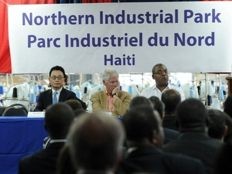|
|
|

Haiti - Economy : North Industrial Park, all the details
21/01/2011 15:50:40
The Government of Haiti, the United States Government through the Department of State, and the Inter-American Development Bank closed a deal to build an industrial park in the Haiti's North Corridor with Sae-A Trading Co. Ltd., Korea's leading garment manufacturer, as the anchor tenant. The North Industrial Park, which is projected to create 20,000 permanent jobs through Sae-A's investment alone, fulfills priorities in the Government of Haiti's National Action Plan to create centers of economic development outside of Port-au-Prince for Haiti's future growth and to bring much needed jobs to Haiti's underserved regions. The Interim Haiti Recovery Commission (IHRC) facilitated and approved this effort, marking the first major public-private partnership to bring permanent jobs to Haiti since the January 12, 2010 earthquake.
The U.S. Congress's passage of the Haiti Economic Lift Program (HELP) Act in May 2010 was a critical catalyst by significantly increasing U.S. trade preferences for Haitian apparel, which in turn made Haiti more attractive to large scale manufacturing operations like Sae-A. Each signatory has committed to investments in the development of the Park and the surrounding area, including park infrastructure, housing, waste-water treatment, port modernization and electrification. This agreement brings to fruition the Memorandum of Understanding signed in September on the margins of the United Nations General Assembly, where the parties agreed to explore the viability of a globally competitive industrial park and major manufacturing operation in Northern Haiti. Park operation and manufacturing activity is projected to begin in the first quarter of 2012.
The Park will:
- Create 20,000 full-time Haitian jobs in the first phase with Sae-A's investment alone, making it the largest private employer in Haiti.
- Create in excess of $500 million in wages and benefits over ten years.
- Directly support the livelihoods of 100,000 to 120,000 Haitians.
- Grow to support 65,000 permanent jobs once the Park is fully developed—increasing Haitian garment industry related jobs by more than 200%.
- Grow the number of formal registered private sector jobs in Haiti by at least 20%
- Create Haiti's first textile mill with knitting & dyeing.
- Be the first manufacturer to produce apparel with textiles made in Haiti, reducing dependence on imported raw materials and dramatically increasing the value added component in Haiti for each garment manufactured.
- Grow the tax base through increased employment and trade flows.
Investment in the Park will also:
- Include local housing development in nearby communities, including at least 5,000 homes
- Result in a modern port for the Northern region and a rehabilitated road network benefitting the Park as well as other industries such as tourism and agriculture.
- Provide electricity beyond the Park's grounds in surrounding areas that currently lack access to an electric grid.
- Create, in addition to the first 20,000 jobs created by Sae-A, and additional 15,000 or more jobs as the first phase of the park is built out in microenterprises, smallholder farming, food vending or financial services.
- Double, through Sae-A's investment, the Foreign Direct Investment Haiti received in all of 2009.
Each party's commitments:
- Sae-A will commit at least $78 million for facility development, machinery and equipment. It will occupy 50 hectares and employ 20,000 Haitian workers in compliance with International Labor Organization standards.
- The Government of Haiti will, as owners of the Park, contract for park management and provide support and oversight, including ensuring new construction adheres to earthquake and hurricane resistant standards.
- The United States Government will provide more than $120 million in grant funding for the Park's power generation, housing in communities in proximity to the Park and port improvements.
- The Inter-American Development Bank will invest at least $50 million in grant funding for the development of factory shells and inside-the-fence infrastructure.
- While not party to the agreement, the European Union is making grant funding investments to support road improvements, including critical access roads and major arteries in the North.
Background on the garment industry in Haiti:
- Twenty years ago, Haiti's apparel industry was a reliable supplier of assembled goods to the U.S. market and employed as many as 100,000 workers. Today, the industry employs approximately 28,000 workers.
- The value of Haitian apparel exports to the United States ($512 million) was approximately 10 percent of Haiti's GDP in 2009, constituting approximately 90 percent of the country's exports.
- With the passage of the HELP Act by the U.S. Congress, firms in the apparel industry have expressed interest in expanding sourcing in Haiti to benefit from improved duty-free access to the U.S. market.
- Garment manufactures operating in Haiti have added over 4,000 jobs to the industry since the January 12 earthquake. Not only have jobs lost immediately after the disaster been recovered, the industry now employs more people than before the earthquake. The largest companies have outlined aggressive investment plans to expand further to benefit from enhanced trade preferences.
- Daily instruction and information in garment factories has also successfully kept incidences of cholera at bay in the industry. Educating the workforce on hygiene and sanitation, along with distributing water purification tablets, has resulted in only two cases of cholera being reported and treated in Haitian factories.
Haitians need something more fundamental than relief from the present situation; they need jobs that they can count on for years ahead. For this, the private business sector is essential.
HL/ HaïtiLibre/ Paul Collier, Economist
|
|
|
|



